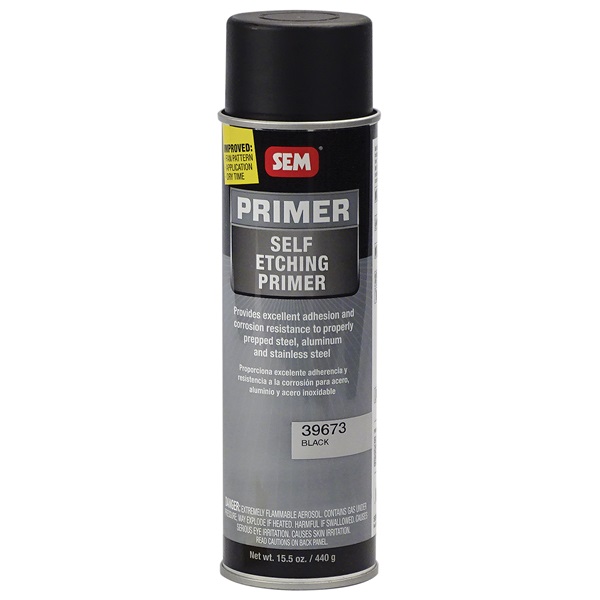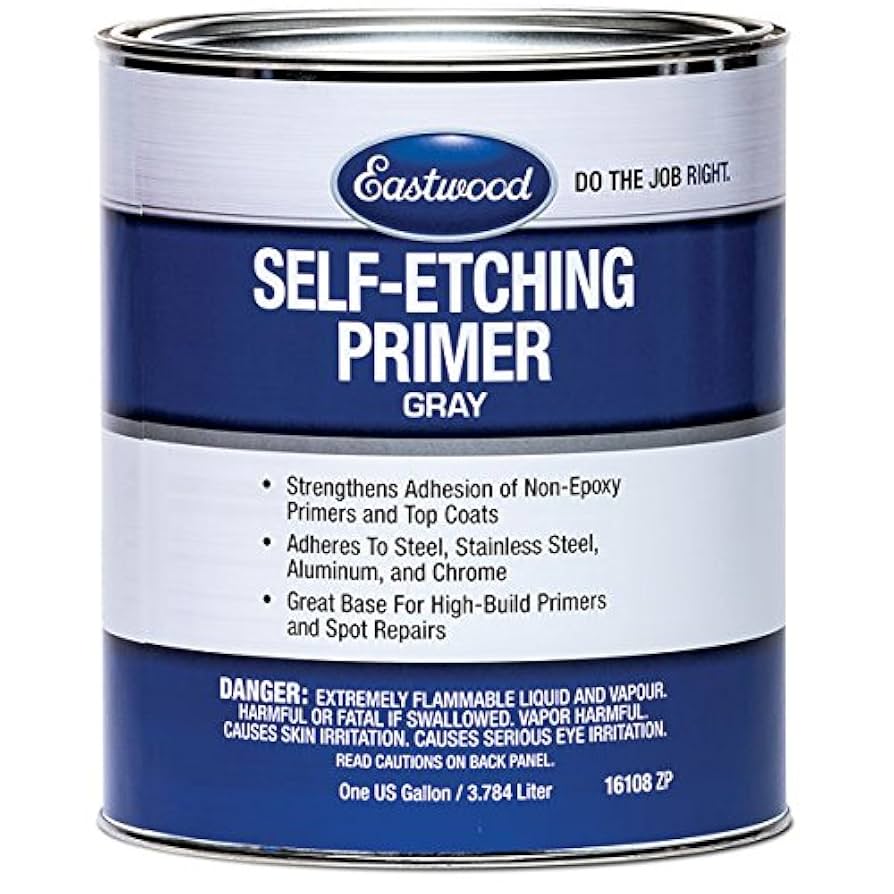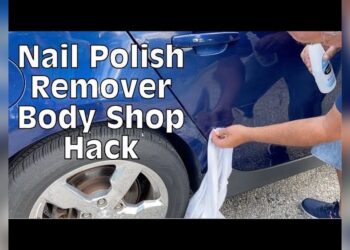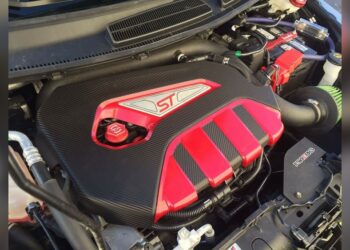If you’re looking to give your chrome surfaces a fresh, lasting finish, you’ve probably wondered how to make paint stick to that shiny, smooth metal. Chrome’s slick nature makes it tricky for paint to bond properly, but that’s where self-etching primer comes in.
This special primer chemically bites into the chrome, creating a rougher surface that helps your paint stay put for the long haul. You’ll discover exactly how to prep your chrome, which primers work best, and simple steps you can follow to achieve a flawless, durable paint job.
Ready to transform your chrome with confidence? Keep reading and learn how to get professional results every time.
Why Use Self Etching Primer On Chrome
Using self etching primer on chrome is crucial for a strong paint bond. Chrome surfaces are smooth and non-porous. This makes paint stick poorly without proper preparation. Self etching primer creates a rough base on chrome. It allows paint to grip the surface firmly. This primer also protects chrome from rust and corrosion. Applying it ensures long lasting and durable paint jobs on chrome parts.
Benefits For Adhesion
Self etching primer improves paint adhesion on chrome significantly. It contains acids that lightly etch the chrome surface. This roughens the surface texture at a microscopic level. Paint can then hold tightly to the primer and chrome. Without this primer, paint tends to peel or chip easily. The primer acts as a bridge between smooth chrome and paint layers. This results in a stronger and more reliable finish.
Chemical Etching Process
The chemical etching process involves mild acid in the primer. This acid gently breaks down the chrome surface layer. It creates tiny pores and rough spots on the chrome. These pores increase surface area and improve mechanical bonding. The etching process also cleans the surface of oils and dirt. This ensures the primer adheres well and forms a solid base. The chemical action is controlled to avoid damaging the chrome.
Compatibility With Chrome Surfaces
Self etching primers are designed to work on chrome and similar metals. They bond well to chrome, aluminum, and steel. This compatibility makes them ideal for automotive and decorative chrome parts. The primer’s formula resists peeling and corrosion on chrome. It also works with different types of paint finishes. Choosing a self etching primer made for chrome ensures a smooth and lasting paint job.

Credit: www.tptools.com
Preparing Chrome For Priming
Preparing chrome for priming is a key step for lasting paint adhesion. Chrome surfaces are smooth and non-porous, so they need special care before applying primer. Proper preparation removes oils and dirt and creates a rough surface for the primer to hold on.
Following simple steps improves the primer’s grip and helps avoid peeling or flaking later. Clean chrome looks better and lets the primer work at its best.
Cleaning And Degreasing
Start by washing the chrome with soap and water. This removes dirt and loose debris. Next, use a degreaser or rubbing alcohol to clear oils and grease. These substances block primer bonding. Wipe the surface with a clean cloth after applying degreaser. Make sure the chrome is dry before moving on.
Surface Scuffing Techniques
Use fine-grit sandpaper or a scuff pad to roughen the chrome surface. This helps the primer stick better. Lightly scuff in a circular motion. Avoid sanding too hard, which can damage the chrome. After scuffing, wipe the surface with a tack cloth to remove dust. Proper scuffing creates tiny scratches for better primer grip.
Removing Contaminants
Check the chrome for any remaining contaminants like wax or silicone. These can prevent proper adhesion. Use a dedicated wax and grease remover for best results. Apply it with a lint-free cloth and wipe thoroughly. Ensure no residue is left behind. Clean chrome ensures the primer bonds deeply and lasts longer.
Choosing The Right Primer
Choosing the right primer for chrome surfaces plays a key role in achieving strong paint adhesion. Chrome is smooth and non-porous, which makes paint stick poorly without proper preparation. Selecting a primer designed to bond with chrome ensures durability and a smooth finish. Various primer types and formulations target chrome, each with unique benefits and limitations. Understanding these options helps in making the best choice for your project.
Self Etching Vs Epoxy Primers
Self etching primers contain acids that lightly etch chrome surfaces. This creates a rough texture that helps paint stick better. They dry quickly and are easy to apply. Epoxy primers offer excellent corrosion resistance and stronger adhesion. They form a hard, durable layer that bonds tightly to metal. Epoxy primers usually require more preparation and longer drying times. For chrome, self etching primers work well for light prep jobs. Epoxy primers suit heavy-duty projects needing extra protection.
Top Brands And Products
Popular self etching primers include Rust-Oleum, Dupli-Color, and SEM. Rust-Oleum offers affordable options with good coverage. Dupli-Color provides primers designed for automotive use on chrome. SEM self etching primers are highly regarded for quality and durability. These brands are widely available at stores like Home Depot, O’Reilly Auto Parts, and Walmart. Choose a primer with clear instructions and positive reviews for the best results.
Primer Formulations For Chrome
Primers for chrome usually contain special acids to etch the surface. Some formulas include zinc or phosphate for extra rust protection. Spray primers offer easy application on complex shapes. Brush-on primers provide control for small areas or touch-ups. Some primers combine self etching with epoxy components for better adhesion. Always check the label to confirm suitability for chrome and follow the manufacturer’s prep instructions closely.

Credit: neurohero.com
Application Steps For Best Results
Applying self-etching primer on chrome requires careful steps for the best results. Chrome surfaces are smooth and shiny, so proper preparation and technique are key. Follow the steps closely to ensure the primer bonds well and lasts longer.
Proper Primer Application
Start by cleaning the chrome surface thoroughly. Remove dirt, grease, and oils using a degreaser or soap. Lightly sand the chrome with fine-grit sandpaper to create a rough surface. This helps the primer stick better.
Shake the primer can well before use. Apply a thin, even coat of self-etching primer. Hold the spray about 6 to 8 inches from the surface. Avoid heavy layers that can drip or peel.
Allow the first coat to dry slightly, then apply a second coat. Two coats give better coverage and stronger adhesion. Let the primer cover all parts of the chrome evenly.
Drying And Curing Times
Let the primer dry at room temperature. Usually, it takes about 15 to 30 minutes to become touch-dry. Avoid touching the surface during this time.
Full curing takes longer—up to 24 hours. This allows the primer to harden completely and bond with the chrome. Paint or topcoat should be applied only after full curing.
Check the product label for exact drying and curing times. Different brands may vary slightly.
Common Mistakes To Avoid
Do not skip surface cleaning or sanding. Without this, the primer will not adhere properly. Avoid applying thick coats that cause runs or bubbles.
Do not paint over the primer too soon. Painting on wet primer can cause peeling. Avoid using incompatible paint types that do not bond well with self-etching primer.
Failing to let the primer cure fully reduces durability. Patience is key for a long-lasting finish on chrome surfaces.
Painting Over Chrome After Priming
Painting over chrome after applying a self-etching primer creates a strong base for the paint. The primer helps the paint stick well on the shiny, smooth surface of chrome. Proper selection of top coats and painting techniques improves the finish and durability of the paint job.
Selecting Compatible Top Coats
Choose top coats that bond well with self-etching primers. Acrylic enamel and urethane paints work best on primed chrome. These paints provide good coverage and resist peeling. Avoid using paints that do not match the primer type. Check the product label for compatibility. Using the right top coat ensures a lasting and even finish.
Techniques For Smooth Finish
Start with thin, even coats of paint over the primer. Use light, sweeping strokes to avoid runs and drips. Allow each coat to dry fully before applying the next. Sand lightly between coats if needed for smoothness. Use a spray gun or aerosol paint for better control. Proper technique prevents uneven texture and improves appearance.
Long-term Durability Tips
After painting, let the surface cure completely before use. Avoid harsh chemicals or abrasive cleaning on the painted chrome. Apply a clear coat to protect paint from scratches and weather. Regular washing with mild soap keeps the finish fresh. Store painted items indoors or cover them to prevent damage from sun and rain.

Credit: www.amazon.com
Troubleshooting Adhesion Problems
Troubleshooting adhesion problems is key when using self-etching primer on chrome. Poor adhesion can cause paint to peel or bubble, ruining the finish. Understanding common signs and knowing how to fix issues helps keep your project looking great. This section guides you through spotting problems and correcting them efficiently.
Signs Of Poor Adhesion
Look for paint that peels, bubbles, or cracks on the chrome surface. Blisters or rough patches also show poor primer bonding. If the paint rubs off easily, adhesion is weak. These signs mean the primer did not stick well to the metal.
Fixing Paint Peeling
First, remove all loose paint and primer using a scraper or sandpaper. Clean the chrome thoroughly to remove oils and dirt. Reapply self-etching primer on the bare metal areas. Let it dry fully before painting again. This process restores a strong bond between paint and chrome.
When To Reapply Primer
Reapply primer if you notice any adhesion problems after the first coat. Also, if the primer was applied unevenly or too thin, a second coat helps. Always wait for the recommended drying time before painting. Proper priming ensures paint sticks well and lasts longer on chrome.
Alternative Methods For Chrome Painting
Painting chrome surfaces can be tricky due to their smooth and shiny finish. Many seek alternatives to self-etching primers to ensure paint sticks well and lasts longer. Exploring other methods helps find the best option for durability and appearance. Below are some practical alternatives for painting chrome.
Using Epoxy Or Dtm Sealers
Epoxy primers and direct-to-metal (DTM) sealers offer strong adhesion on chrome. They create a tough base that bonds well with paint. These sealers resist rust and corrosion, extending the life of the paint job. Surface preparation remains crucial; sanding or scuffing chrome enhances primer grip. Epoxy and DTM products often dry faster and provide a smoother finish than self-etching primers. These options suit both indoor and outdoor chrome applications.
Powder Coating Options
Powder coating gives a thick, even finish that sticks firmly to chrome. It involves applying dry powder, then curing it under heat. This creates a durable, chip-resistant layer. Powder coating resists scratching and fading better than liquid paint. It is available in many colors and textures for customization. Proper surface cleaning and pretreatment are key to powder coating success on chrome. This method suits parts exposed to heavy wear or weather.
Chrome Plating Vs Painting
Chrome plating adds a real metal layer, unlike painting which covers the surface. Plating offers superior shine and durability but costs more. It protects metal from rust and damage for years. Painting chrome is cheaper and easier for color changes or repairs. Paint can peel or chip without good preparation. Chrome plating requires specialized equipment and skills, while painting can be DIY-friendly. Choose plating for a long-lasting finish or paint for flexibility and budget.
Maintenance And Care For Painted Chrome
Maintaining painted chrome surfaces ensures their shine and protection last longer. Proper care prevents damage and keeps the finish smooth. Regular attention helps avoid rust and corrosion. Simple steps extend the life of the painted chrome.
Cleaning Painted Chrome Surfaces
Use a soft cloth to clean painted chrome. Avoid abrasive materials that can scratch the paint. Mild soap and water work best for dirt removal. Rinse thoroughly and dry with a clean towel. Cleaning often prevents buildup and keeps the surface bright.
Preventing Rust And Corrosion
Keep painted chrome dry to stop rust from forming. Inspect surfaces regularly for chips or cracks. Apply a protective wax or sealant to add a barrier. Store items away from moisture and harsh weather. Early care limits corrosion and protects the paint.
Touch-up And Repair Tips
Fix small chips quickly to avoid rust spots. Clean the area before applying touch-up paint. Use a self-etching primer for strong adhesion on chrome. Apply paint in thin layers and let each dry. Finish with a clear coat to seal and protect the repair.
Frequently Asked Questions
Can I Use Self-etching Primer On Chrome?
Yes, you can use self-etching primer on properly cleaned and scuffed chrome. It improves paint adhesion by etching the surface. For stronger durability, consider epoxy or direct-to-metal primers instead. Always follow the primer manufacturer’s instructions for best results.
What Kind Of Primer Will Stick To Chrome?
Use a self-etching primer designed for chrome, like Rust-Oleum or Dupli-Color. Properly clean and scuff the surface first. For stronger adhesion, consider epoxy or direct-to-metal (DTM) primers. These primers chemically etch chrome, ensuring paint sticks well and lasts longer.
When Not To Use Self-etching Primer?
Avoid using self-etching primer on plastic, fiberglass, or already painted surfaces. Do not apply it on rusty or oily metals.
Can You Use Self-etching Primer On Metal?
Yes, you can use self-etching primer on properly cleaned and scuffed metal. It improves adhesion by chemically etching the surface. For best results on chrome, consider epoxy or direct-to-metal primers. Always follow the manufacturer’s instructions for application and drying times.
Can Self-etching Primer Stick Well On Chrome Surfaces?
Yes, if the chrome is cleaned and scuffed well, self-etching primer can stick effectively.
Conclusion
Using self-etching primer on chrome helps paint stick better. Clean the surface well before application. Light sanding improves primer grip on chrome. Follow all instructions for best results. For stronger hold, consider epoxy primers too. Proper prep leads to a smooth, lasting finish.
This simple step saves time and effort later. Paint your chrome projects with confidence and care.

















